2001 NISSAN X-TRAIL power steering
[x] Cancel search: power steeringPage 2867 of 3833
![NISSAN X-TRAIL 2001 Service Repair Manual TROUBLE DIAGNOSIS
BRC-83
[ESP/TCS/ABS]
C
D
E
G
H
I
J
K
L
MA
B
BRC
(note) “ACTUATOR RLY” on the CONSULT-II self-diagnosis results indicates the malfunction of the actuator motor relay and circuit.
NISSAN X-TRAIL 2001 Service Repair Manual TROUBLE DIAGNOSIS
BRC-83
[ESP/TCS/ABS]
C
D
E
G
H
I
J
K
L
MA
B
BRC
(note) “ACTUATOR RLY” on the CONSULT-II self-diagnosis results indicates the malfunction of the actuator motor relay and circuit.](/manual-img/5/57405/w960_57405-2866.png)
TROUBLE DIAGNOSIS
BRC-83
[ESP/TCS/ABS]
C
D
E
G
H
I
J
K
L
MA
B
BRC
(note) “ACTUATOR RLY” on the CONSULT-II self-diagnosis results indicates the malfunction of the actuator motor relay and circuit.
DATA MONITOR
For details of the data monitor function, refer to the CONSULT-II Instruction Manual.
USV LINE [FL-RR]ESP switch-over solenoid valve 1 on the primary side is open cir-
cuit or shorted, or the control line is open or shorted to the power
supply or the ground.
ESP switch-over sole-
noid valve and circuit.
Refer to BRC-99
. USV LINE [FR-RL]ESP switch-over solenoid valve 1 on the secondary side is open
circuit or shorted, or the control line is open or shorted to the
power supply or the ground.
HSV LINE [FL-RR]ESP switch-over solenoid valve 2 on the primary side is open cir-
cuit or shorted, or the control line is open or shorted to the power
supply or the ground.
HSV LINE [FR-RL]ESP switch-over solenoid valve 2 on the secondary side is open
circuit or shorted, or the control line is open or shorted to the
power supply or the ground.
PUMP MOTOR
ACTUATOR RLY (note) During the actuator motor operation with ON, when the actuator
motor turns OFF. Or when the control line for actuator motor relay
is open.Actuator motor, motor
relay, and circuit. Refer
to BRC-102
During the actuator motor operation with OFF, when the actuator
motor turns ON. Or when the control line for relay is shorted to
ground.
ABS SENSOR
[ABNORMAL SIGNAL]Wheel sensor input is abnormal.Wheel sensor and cir-
cuit. Refer to BRC-92
BATTERY VOLTAGE
[ABNORMAL]ESP/TCS/ABS control unit battery voltage is too low.ESP/TCS/ABS control
unit battery voltage cir-
cuit and ground circuit.
Refer to BRC-106
ST ANGLE SEN SIGNALNeutral position correction of steering wheel angle sensor is not
finished.Neutral position adjust-
ment of steering wheel
angle sensor. Refer to
BRC-108
ST ANG SEN COM CIRCAN communication system or steering wheel angle sensor is
abnormal.Steering wheel angle
sensor and CAN com-
munication circuit. Refer
to BRC-110
SIDE G-SEN CIRCUITSide G sensor is abnormal, or the signal line of side G sensor is
open or shorted.Yaw rate and Side G
sensor and circuit. Refer
to BRC-98
EMERGENCY BRAKEESP/TCS/ABS control unit malfunction (pressure increase is too
much or too little.)ESP/TCS/ABS control
unit. Refer to BRC-108
CONTROLLER FAILURE ESP/TCS/ABS internal malfunction of control unitESP/TCS/ABS control
unit. Refer to BRC-94
CAN COMM CIRCUIT
●CAN communication line is open or shorted.
●ESP/TCS/ABS control unit internal malfunction.
●Battery voltage for EMC is interrupted instantaneously for
Approx. 0.5 seconds or more.Communication circuit
between ESP/TCS/ABS
control unit and units.
Refer to BRC-110
BR FLUID LEVEL LOWBrake fluid level drops or communication line between the ESP/
TCS/ABS control unit and the brake fluid level warning switch is
open or shorted. Communication circuit
between the ESP/TCS/
ABS control unit and the
brake fluid level warning
switch.
Reservoir tank fluid.
Refer to BRC-109
ENGINE SIGNAL 1-4, 6 Major engine components are abnormal Engine system. Refer to
BRC-94
Self-Diagnostic item Malfunction detecting condition Check route
Page 2892 of 3833
![NISSAN X-TRAIL 2001 Service Repair Manual BRC-108
[ESP/TCS/ABS]
TROUBLE DIAGNOSIS
5. ESP/TCS/ABS CONTROL UNIT POWER SUPPLY CIRCUIT INSPECTION 2
1. Check the fuse 10A.
2. Check for continuity between the battery positive terminal and
t NISSAN X-TRAIL 2001 Service Repair Manual BRC-108
[ESP/TCS/ABS]
TROUBLE DIAGNOSIS
5. ESP/TCS/ABS CONTROL UNIT POWER SUPPLY CIRCUIT INSPECTION 2
1. Check the fuse 10A.
2. Check for continuity between the battery positive terminal and
t](/manual-img/5/57405/w960_57405-2891.png)
BRC-108
[ESP/TCS/ABS]
TROUBLE DIAGNOSIS
5. ESP/TCS/ABS CONTROL UNIT POWER SUPPLY CIRCUIT INSPECTION 2
1. Check the fuse 10A.
2. Check for continuity between the battery positive terminal and
the ESP/TCS/ABS control unit (vehicle-side connector B111).
Is inspection result OK?
YES >> Check the battery for a loose terminal and low voltage or the alternator for abnormality.
NO >>
●Replace the fuse 10A.
●Harness disconnection
Inspection 12 When “EMERGENCY BRAKE” is indicated in the Self-Diagnosis
Results
EFS001AO
Inspection procedure
1. SELF-DIAGNOSIS RESULT CHECK
Check the self-diagnosis results.
When any items other than “EMERGENCY BRAKE” is displayed in the self-diagnosis results, follow the
instructions below.
CAUTION:
“EMERGENCY BRAKE” is indicated when the control unit itself is detected internal error. If this dis-
play item was indicated, replace the control unit.
Is
“EMERGENCY BRAKE” is indicated in the self-diagnosis results?
>> Replace the ESP/TCS/ABS control unit, and perform the self-diagnosis again.
Inspection 13 When “ST ANG SEN SIGNAL” is Indicated in the Self-Diagnosis
Results
EFS001AP
Inspection procedure
1. SELF-DIAGNOSIS RESULT CHECK 1
Check the self-diagnosis results.
When any items other than
“ST ANGLE SEN SIGNAL” is displayed in the self-diagnosis results:
YES >> Check and repair the applicable items. Perform the self-diagnosis again.
NO >> Perform the steering wheel angle sensor neutral position adjustment. GO TO 2.
SFIA0924E
ESP/TCS/ABS control unit
(Vehicle-side connector B111)Battery terminal Continuity
1 (G/R) positive Yes
Self-diagnosis results
CONSUL-II indication item
EMERGENCY BRAKE
Self-diagnosis results
CONSUL-II indication item
ST ANGLE SEN SIGNAL
Page 2911 of 3833
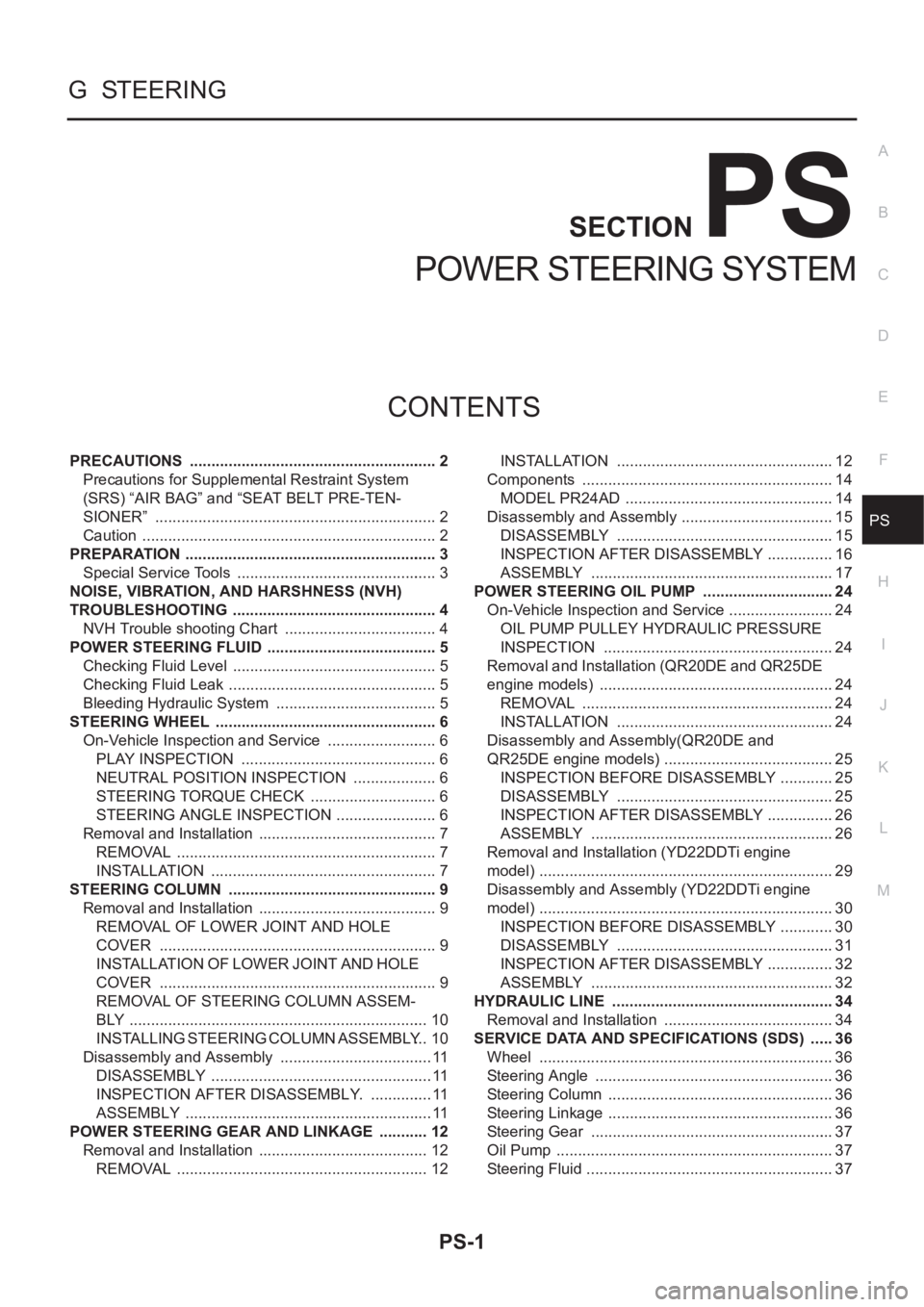
PS-1
POWER STEERING SYSTEM
G STEERING
CONTENTS
C
D
E
F
H
I
J
K
L
M
SECTION
A
B
PS
POWER STEERING SYSTEM
PRECAUTIONS .......................................................... 2
Precautions for Supplemental Restraint System
(SRS) “AIR BAG” and “SEAT BELT PRE-TEN-
SIONER” .................................................................. 2
Caution ..................................................................... 2
PREPARATION ........................................................... 3
Special Service Tools ............................................... 3
NOISE, VIBRATION, AND HARSHNESS (NVH)
TROUBLESHOOTING ................................................ 4
NVH Trouble shooting Chart .................................... 4
POWER STEERING FLUID ........................................ 5
Checking Fluid Level ........................................... ..... 5
Checking Fluid Leak ............................................ ..... 5
Bleeding Hydraulic System ...................................... 5
STEERING WHEEL .................................................... 6
On-Vehicle Inspection and Service .......................... 6
PLAY INSPECTION .............................................. 6
NEUTRAL POSITION INSPECTION .................... 6
STEERING TORQUE CHECK .............................. 6
STEERING ANGLE INSPECTION ........................ 6
Removal and Installation .......................................... 7
REMOVAL ............................................................. 7
INSTALLATION ..................................................... 7
STEERING COLUMN ................................................. 9
Removal and Installation .......................................... 9
REMOVAL OF LOWER JOINT AND HOLE
COVER ................................................................. 9
INSTALLATION OF LOWER JOINT AND HOLE
COVER ................................................................. 9
REMOVAL OF STEERING COLUMN ASSEM-
BLY ...................................................................... 10
INSTALLING STEERING COLUMN ASSEMBLY ... 10
Disassembly and Assembly .................................... 11
DISASSEMBLY .................................................... 11
INSPECTION AFTER DISASSEMBLY. ............... 11
ASSEMBLY .......................................................... 11
POWER STEERING GEAR AND LINKAGE ............ 12
Removal and Installation ........................................ 12
REMOVAL ........................................................... 12INSTALLATION ................................................... 12
Components ........................................................... 14
MODEL PR24AD ................................................. 14
Disassembly and Assembly .................................... 15
DISASSEMBLY ................................................... 15
INSPECTION AFTER DISASSEMBLY ................ 16
ASSEMBLY ......................................................... 17
POWER STEERING OIL PUMP ............................... 24
On-Vehicle Inspection and Service ......................... 24
OIL PUMP PULLEY HYDRAULIC PRESSURE
INSPECTION ...................................................... 24
Removal and Installation (QR20DE and QR25DE
engine models) ....................................................... 24
REMOVAL ........................................................... 24
INSTALLATION ................................................... 24
Disassembly and Assembly(QR20DE and
QR25DE engine models) ........................................ 25
INSPECTION BEFORE DISASSEMBLY ............. 25
DISASSEMBLY ................................................... 25
INSPECTION AFTER DISASSEMBLY ................ 26
ASSEMBLY ......................................................... 26
Removal and Installation (YD22DDTi engine
model) ..................................................................... 29
Disassembly and Assembly (YD22DDTi engine
model) ..................................................................... 30
INSPECTION BEFORE DISASSEMBLY ............. 30
DISASSEMBLY ................................................... 31
INSPECTION AFTER DISASSEMBLY ................ 32
ASSEMBLY ......................................................... 32
HYDRAULIC LINE .................................................
... 34
Removal and Installation ........................................ 34
SERVICE DATA AND SPECIFICATIONS (SDS) ...... 36
Wheel ..................................................................... 36
Steering Angle ........................................................ 36
Steering Column ..................................................... 36
Steering Linkage ..................................................... 36
Steering Gear ......................................................... 37
Oil Pump ................................................................. 37
Steering Fluid .......................................................... 37
Page 2912 of 3833
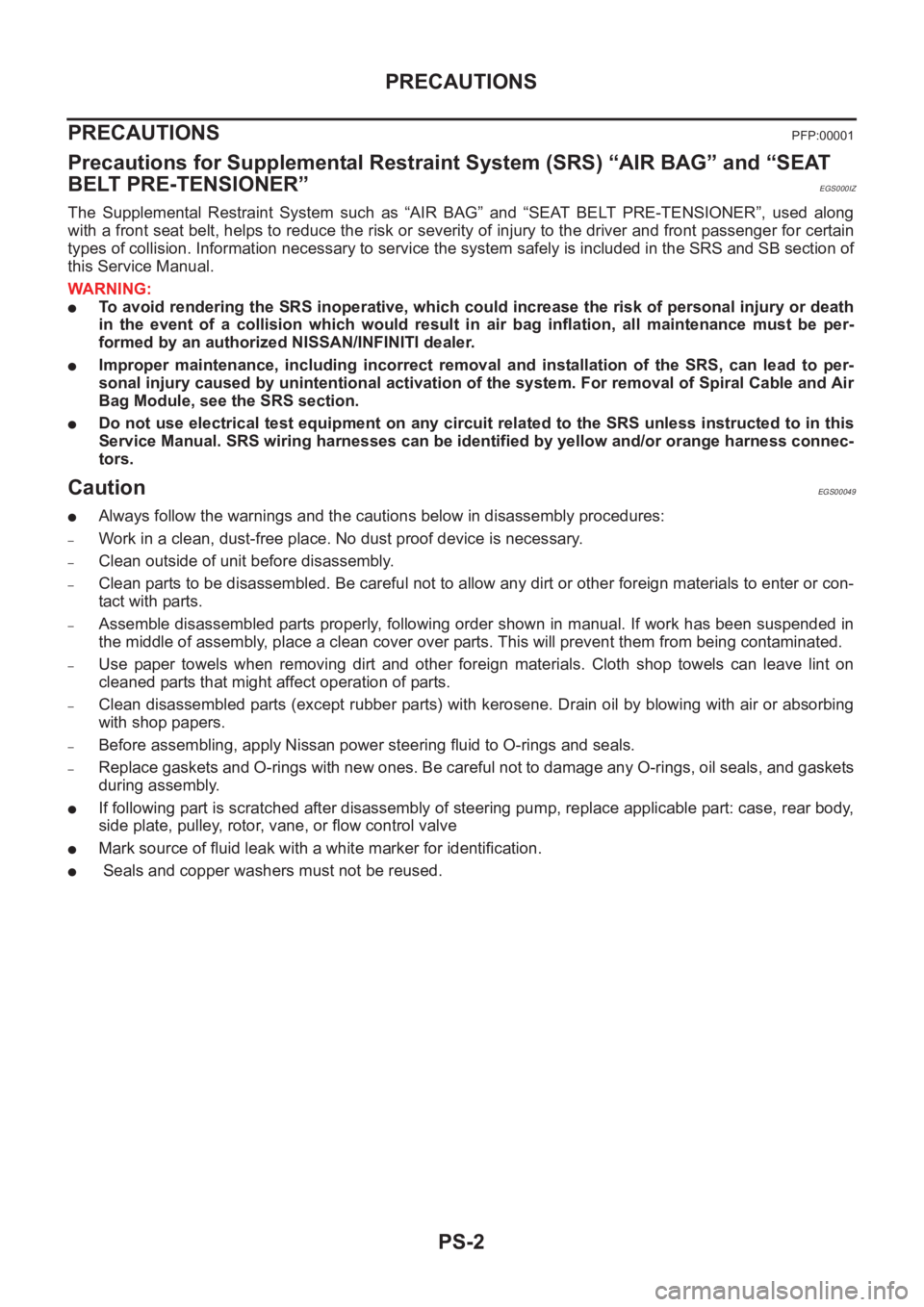
PS-2
PRECAUTIONS
PRECAUTIONS
PFP:00001
Precautions for Supplemental Restraint System (SRS) “AIR BAG” and “SEAT
BELT PRE-TENSIONER”
EGS000IZ
The Supplemental Restraint System such as “AIR BAG” and “SEAT BELT PRE-TENSIONER”, used along
with a front seat belt, helps to reduce the risk or severity of injury to the driver and front passenger for certain
types of collision. Information necessary to service the system safely is included in the SRS and SB section of
this Service Manual.
WARNING:
●To avoid rendering the SRS inoperative, which could increase the risk of personal injury or death
in the event of a collision which would result in air bag inflation, all maintenance must be per-
formed by an authorized NISSAN/INFINITI dealer.
●Improper maintenance, including incorrect removal and installation of the SRS, can lead to per-
sonal injury caused by unintentional activation of the system. For removal of Spiral Cable and Air
Bag Module, see the SRS section.
●Do not use electrical test equipment on any circuit related to the SRS unless instructed to in this
Service Manual. SRS wiring harnesses can be identified by yellow and/or orange harness connec-
tors.
CautionEGS00049
●Always follow the warnings and the cautions below in disassembly procedures:
–Work in a clean, dust-free place. No dust proof device is necessary.
–Clean outside of unit before disassembly.
–Clean parts to be disassembled. Be careful not to allow any dirt or other foreign materials to enter or con-
tact with parts.
–Assemble disassembled parts properly, following order shown in manual. If work has been suspended in
the middle of assembly, place a clean cover over parts. This will prevent them from being contaminated.
–Use paper towels when removing dirt and other foreign materials. Cloth shop towels can leave lint on
cleaned parts that might affect operation of parts.
–Clean disassembled parts (except rubber parts) with kerosene. Drain oil by blowing with air or absorbing
with shop papers.
–Before assembling, apply Nissan power steering fluid to O-rings and seals.
–Replace gaskets and O-rings with new ones. Be careful not to damage any O-rings, oil seals, and gaskets
during assembly.
●If following part is scratched after disassembly of steering pump, replace applicable part: case, rear body,
side plate, pulley, rotor, vane, or flow control valve
●Mark source of fluid leak with a white marker for identification.
● Seals and copper washers must not be reused.
Page 2915 of 3833
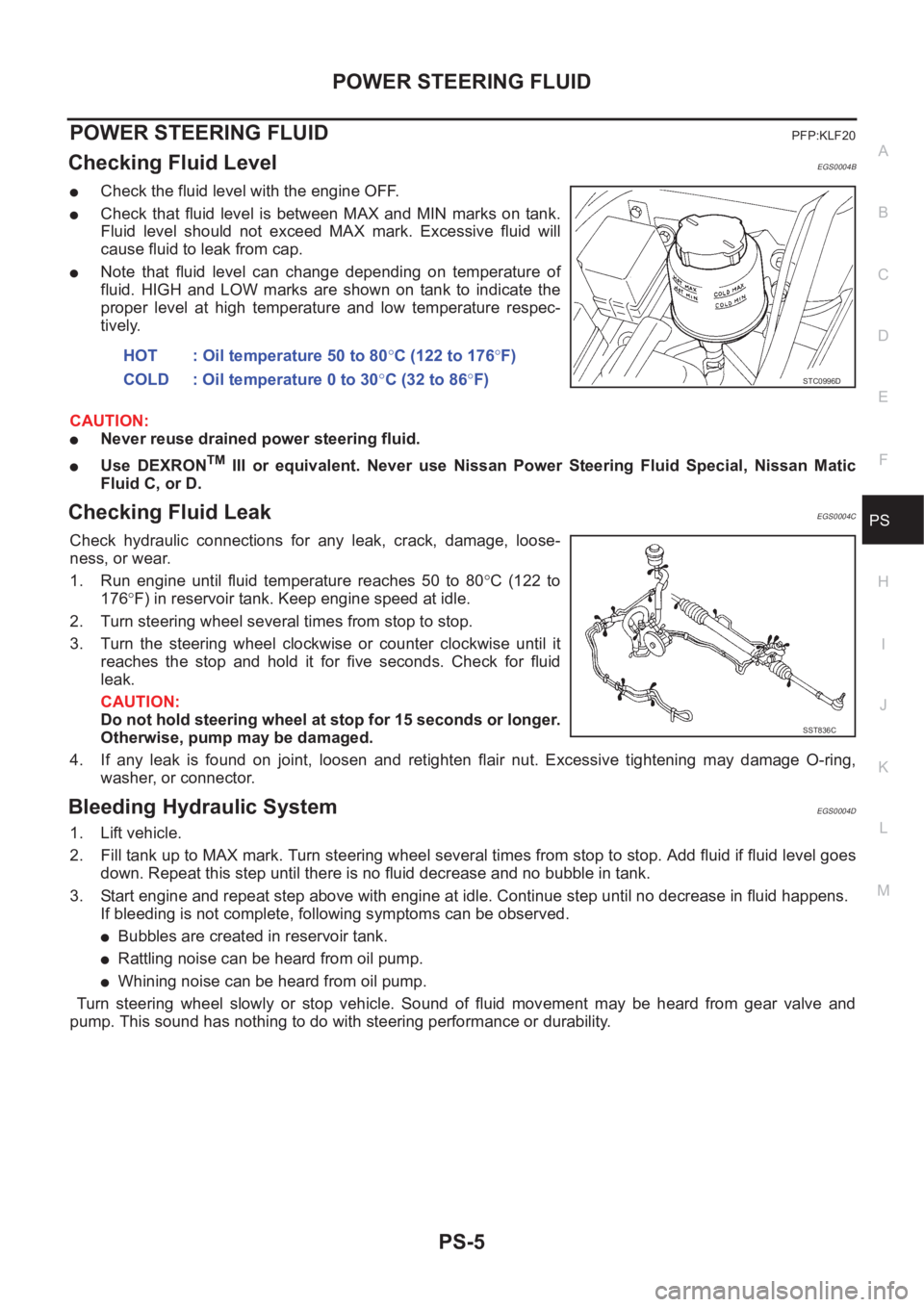
POWER STEERING FLUID
PS-5
C
D
E
F
H
I
J
K
L
MA
B
PS
POWER STEERING FLUIDPFP:KLF20
Checking Fluid LevelEGS0004B
●Check the fluid level with the engine OFF.
●Check that fluid level is between MAX and MIN marks on tank.
Fluid level should not exceed MAX mark. Excessive fluid will
cause fluid to leak from cap.
●Note that fluid level can change depending on temperature of
fluid. HIGH and LOW marks are shown on tank to indicate the
proper level at high temperature and low temperature respec-
tively.
CAUTION:
●Never reuse drained power steering fluid.
●Use DEXRONTM III or equivalent. Never use Nissan Power Steering Fluid Special, Nissan Matic
Fluid C, or D.
Checking Fluid LeakEGS0004C
Check hydraulic connections for any leak, crack, damage, loose-
ness, or wear.
1. Run engine until fluid temperature reaches 50 to 80°C (122 to
176°F) in reservoir tank. Keep engine speed at idle.
2. Turn steering wheel several times from stop to stop.
3. Turn the steering wheel clockwise or counter clockwise until it
reaches the stop and hold it for five seconds. Check for fluid
leak.
CAUTION:
Do not hold steering wheel at stop for 15 seconds or longer.
Otherwise, pump may be damaged.
4. If any leak is found on joint, loosen and retighten flair nut. Excessive tightening may damage O-ring,
washer, or connector.
Bleeding Hydraulic SystemEGS0004D
1. Lift vehicle.
2. Fill tank up to MAX mark. Turn steering wheel several times from stop to stop. Add fluid if fluid level goes
down. Repeat this step until there is no fluid decrease and no bubble in tank.
3. Start engine and repeat step above with engine at idle. Continue step until no decrease in fluid happens.
If bleeding is not complete, following symptoms can be observed.
●Bubbles are created in reservoir tank.
●Rattling noise can be heard from oil pump.
●Whining noise can be heard from oil pump.
Turn steering wheel slowly or stop vehicle. Sound of fluid movement may be heard from gear valve and
pump. This sound has nothing to do with steering performance or durability. HOT : Oil temperature 50 to 80°C (122 to 176°F)
COLD : Oil temperature 0 to 30°C (32 to 86°F)
STC0996D
SST836C
Page 2916 of 3833
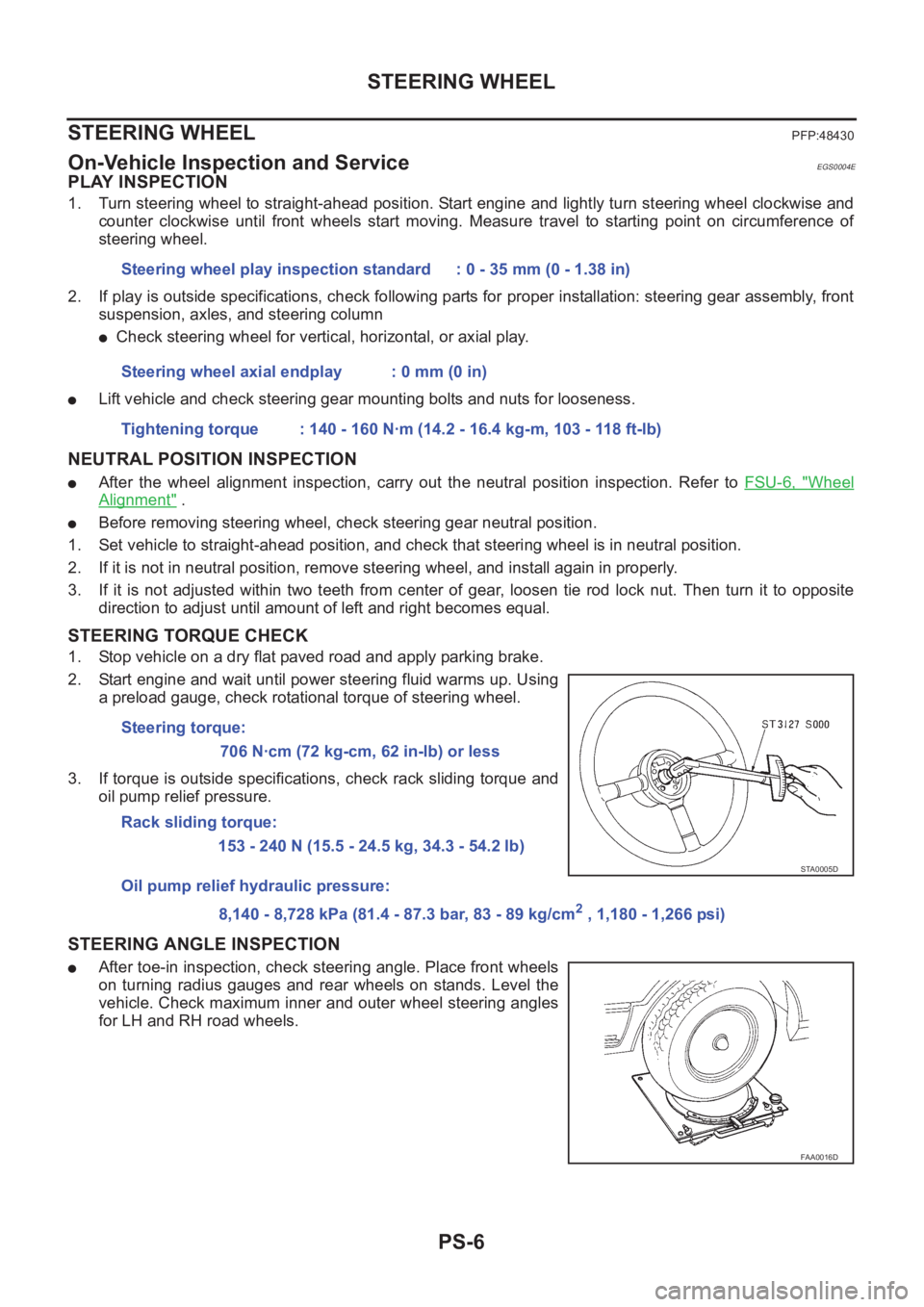
PS-6
STEERING WHEEL
STEERING WHEEL
PFP:48430
On-Vehicle Inspection and ServiceEGS0004E
PLAY INSPECTION
1. Turn steering wheel to straight-ahead position. Start engine and lightly turn steering wheel clockwise and
counter clockwise until front wheels start moving. Measure travel to starting point on circumference of
steering wheel.
2. If play is outside specifications, check following parts for proper installation: steering gear assembly, front
suspension, axles, and steering column
●Check steering wheel for vertical, horizontal, or axial play.
●Lift vehicle and check steering gear mounting bolts and nuts for looseness.
NEUTRAL POSITION INSPECTION
●After the wheel alignment inspection, carry out the neutral position inspection. Refer to FSU-6, "Wheel
Alignment" .
●Before removing steering wheel, check steering gear neutral position.
1. Set vehicle to straight-ahead position, and check that steering wheel is in neutral position.
2. If it is not in neutral position, remove steering wheel, and install again in properly.
3. If it is not adjusted within two teeth from center of gear, loosen tie rod lock nut. Then turn it to opposite
direction to adjust until amount of left and right becomes equal.
STEERING TORQUE CHECK
1. Stop vehicle on a dry flat paved road and apply parking brake.
2. Start engine and wait until power steering fluid warms up. Using
a preload gauge, check rotational torque of steering wheel.
3. If torque is outside specifications, check rack sliding torque and
oil pump relief pressure.
STEERING ANGLE INSPECTION
●After toe-in inspection, check steering angle. Place front wheels
on turning radius gauges and rear wheels on stands. Level the
vehicle. Check maximum inner and outer wheel steering angles
for LH and RH road wheels.Steering wheel play inspection standard : 0 - 35 mm (0 - 1.38 in)
Steering wheel axial endplay : 0 mm (0 in)
Tightening torque : 140 - 160 N·m (14.2 - 16.4 kg-m, 103 - 118 ft-lb)
Steering torque:
706 N·cm (72 kg-cm, 62 in-lb) or less
Rack sliding torque:
153 - 240 N (15.5 - 24.5 kg, 34.3 - 54.2 lb)
Oil pump relief hydraulic pressure:
8,140 - 8,728 kPa (81.4 - 87.3 bar, 83 - 89 kg/cm
2 , 1,180 - 1,266 psi)
STA0005D
FAA0016D
Page 2922 of 3833
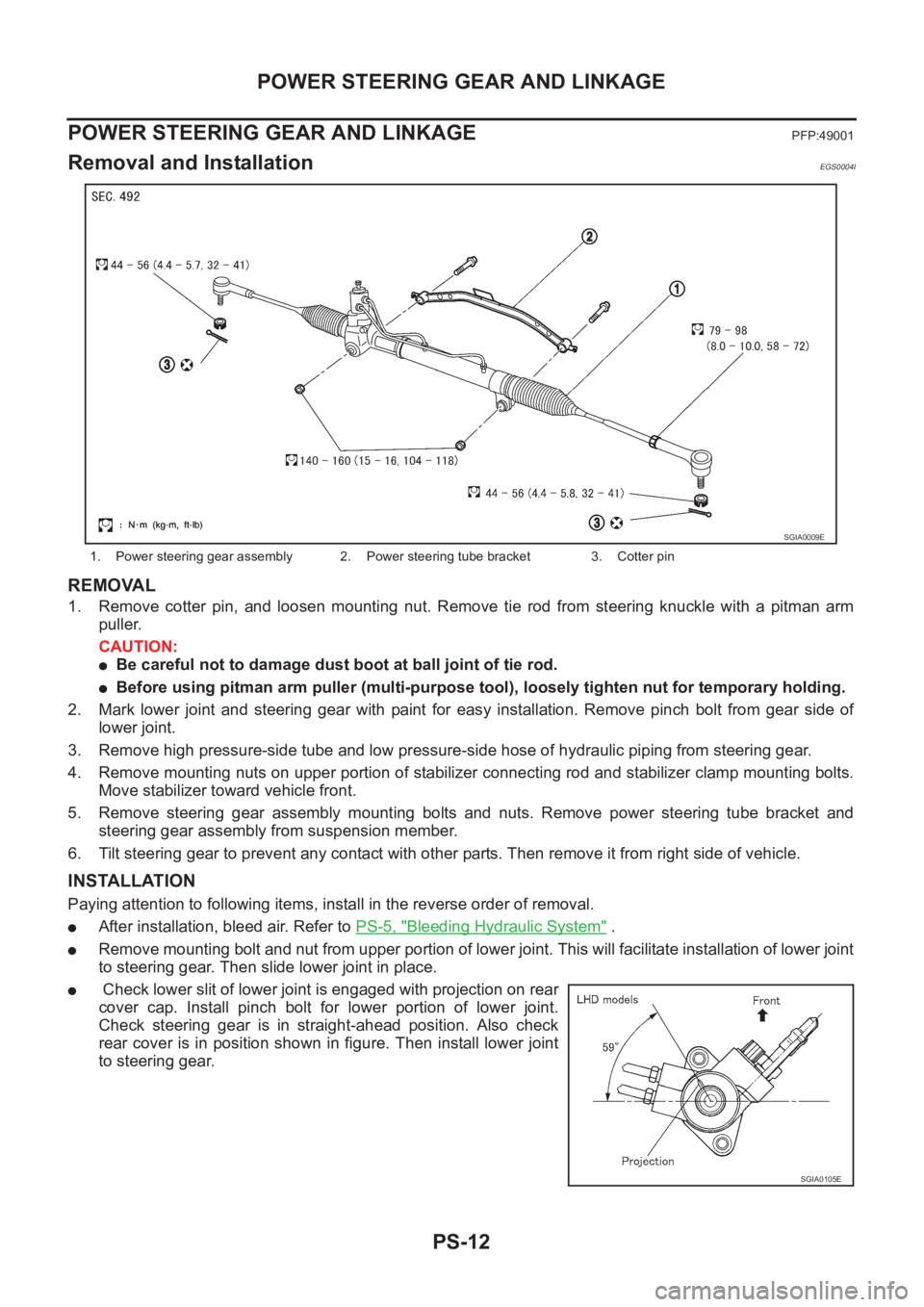
PS-12
POWER STEERING GEAR AND LINKAGE
POWER STEERING GEAR AND LINKAGE
PFP:49001
Removal and InstallationEGS0004I
REMOVAL
1. Remove cotter pin, and loosen mounting nut. Remove tie rod from steering knuckle with a pitman arm
puller.
CAUTION:
●Be careful not to damage dust boot at ball joint of tie rod.
●Before using pitman arm puller (multi-purpose tool), loosely tighten nut for temporary holding.
2. Mark lower joint and steering gear with paint for easy installation. Remove pinch bolt from gear side of
lower joint.
3. Remove high pressure-side tube and low pressure-side hose of hydraulic piping from steering gear.
4. Remove mounting nuts on upper portion of stabilizer connecting rod and stabilizer clamp mounting bolts.
Move stabilizer toward vehicle front.
5. Remove steering gear assembly mounting bolts and nuts. Remove power steering tube bracket and
steering gear assembly from suspension member.
6. Tilt steering gear to prevent any contact with other parts. Then remove it from right side of vehicle.
INSTALLATION
Paying attention to following items, install in the reverse order of removal.
●After installation, bleed air. Refer to PS-5, "Bleeding Hydraulic System" .
●Remove mounting bolt and nut from upper portion of lower joint. This will facilitate installation of lower joint
to steering gear. Then slide lower joint in place.
● Check lower slit of lower joint is engaged with projection on rear
cover cap. Install pinch bolt for lower portion of lower joint.
Check steering gear is in straight-ahead position. Also check
rear cover is in position shown in figure. Then install lower joint
to steering gear.
1. Power steering gear assembly 2. Power steering tube bracket 3. Cotter pin
SGIA0009E
SGIA0105E
Page 2923 of 3833

POWER STEERING GEAR AND LINKAGE
PS-13
C
D
E
F
H
I
J
K
L
MA
B
PS
SGIA0010E